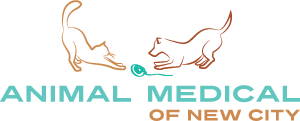Looking for laparoscopic spay near me?
Animal Medical of New City performs minimally invasive laparoscopic spay procedures on dogs and cats. Laparoscopic spays are minimally invasive and less painful than the traditional spay spay procedure. Pets that are spayed laparoscopically recover and heal faster.
According to a 2005 study published in the American Journal of Veterinary Medicine, dogs and cats that were spayed laparoscopically experienced 65% less pain than their counterparts who underwent the traditional spay procedure. 99% of pet owners who have their pets spayed laparoscopically are satisfied with the results.
According to the American College of Veterinary Surgeons:
“Laparoscopic spay has been associated with decreased pain and faster recovery from surgery. It may also result in fewer complications with the surgical wound such as inflammation or infection. Laparoscopic spay generally results in better visualization of the tissue and abdominal cavity. ACVS 2021
What To Expect
Pre-Surgical Visit
Laparoscopic procedure begins with a full physical examination of your pet by one of our veterinarians. She will order a small blood panel to ensure that your pet has no underlying medical conditions and schedule your pet’s surgery.
Day of Surgery
You may drop your pet off the evening before or the morning of her surgery. If you admit her the day of the procedure, please make sure that you don’t give her any food or water 12 hours prior to drop off.
About an hour prior to her surgery, your pet will receive a pre-anesthestic sedative that will keep her feeling calm. We’ll also place a small intravenous catheter.
The Laparoscopic Spay Procedure
A patient about to undergo laparoscopic surgery is fully anesthetized and placed on her back. A small incision is made in her abdomen and the abdominal cavity is slightly inflated with carbon dioxide. Through the same small incision, the doctor introduces the laparoscope, visualizes the ovaries, and removes them (ovariectomy) or will remove the ovaries and uterus (ovariohysterectomy). Your vet will help you decide which is the better option for your pet.
The incisions to the internal tissue during the procedure are very small and are either safely cauterized or sutured using the laparoscope. An entire laparoscopic spay can be completed in about 20 minutes or around half the time it takes to do a traditional spay procedure. Reduced surgery time minimizes risk and decreases recovery time. Best of all, your pet goes home the same day eliminating the need for an overnight hospital stay.
“In a study published in Veterinary Surgery in 2009 by Dr. William Culp and other veterinarians, dogs spayed laparoscopically showed more activity postoperatively than dogs spayed via the routine ovariectomy method.” University of Illinois at Urbana-Champaign College of Veterinary Medicine.
What Are The Benefits Of A Laparoscopic Spay?
- No overnight stay at the hospital, patient goes home same day
- Less invasive (it’s not a full ovarihysterectomy, only the ovaries are removed)
- Much smaller incision than traditional spay
- Less inflammation and risk of infection at incision site
- Better visibility of surgery target reducing the risk of postoperative bleeding
- More precision
- Less postoperative pain
- Faster return to normal activity
How Much Does A Laparoscopic Spay Cost?
Laparoscopic spay costs are very reasonable and priced to make them attractive to pet owners who would otherwise opt for the more invasive, traditional spay procedure. For existing clients and some new ones, Animal Medical has several payment options that can make this reduced-stressed procedure available to nearly all pet owners.

